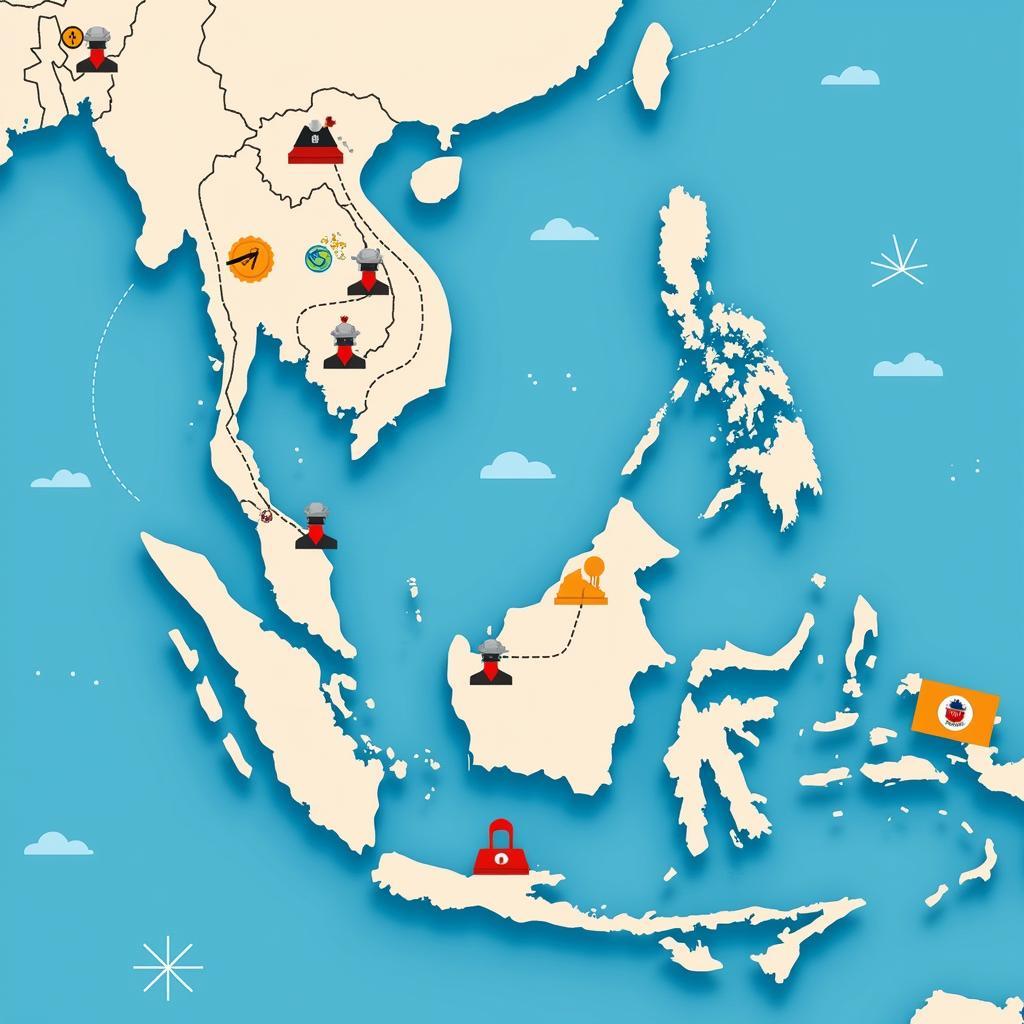The term “Asean 5 Definition” refers to the five founding members of the Association of Southeast Asian Nations (ASEAN): Indonesia, Malaysia, the Philippines, Singapore, and Thailand. These nations laid the groundwork for what ASEAN is today, a vibrant regional bloc striving for economic, political, and socio-cultural cooperation. Understanding the ASEAN 5 is crucial to grasping the historical context, driving forces, and future trajectory of ASEAN integration.
The Birth of ASEAN 5: A Foundation for Regional Cooperation
The ASEAN 5 came together in 1967 amidst a turbulent period in Southeast Asian history. The Cold War was at its height, and the region was grappling with political instability and economic underdevelopment. Recognizing the need for regional solidarity, the foreign ministers of these five nations signed the Bangkok Declaration, marking the official formation of ASEAN. This declaration outlined the core principles of cooperation, including respect for national sovereignty, non-interference in internal affairs, and peaceful settlement of disputes. These principles remain central to ASEAN’s identity today. The ASEAN 5 aimed to create a platform for dialogue and collaboration, fostering peace and prosperity in a region fraught with challenges.
The initial focus of the ASEAN 5 was primarily on political and security cooperation, reflecting the geopolitical realities of the time. However, over the years, the scope of collaboration expanded to encompass economic, social, and cultural dimensions. The ASEAN 5 recognized that sustainable peace and stability could only be achieved through comprehensive regional integration.
Economic Powerhouse: The ASEAN 5’s Contribution to Regional Growth
The ASEAN 5 have played a pivotal role in driving economic growth and development within the region. These nations represent a significant portion of ASEAN’s total GDP and population, making them a key engine of economic activity. They have implemented various initiatives to promote trade and investment, including the ASEAN Free Trade Area (AFTA) and the ASEAN Investment Area (AIA). These agreements have helped to reduce trade barriers, attract foreign investment, and foster greater economic integration among the member states. As early adopters of open market policies and regional cooperation, they laid the groundwork for the broader ASEAN Economic Community (AEC).
For more insight on data and statistics related to ASEAN, you can explore the ASE Free Data Space Ratio available on our website. Additionally, for a broader understanding of peace and tranquility within the ASEAN context, check out ASE Definition Peace Tranquility.
From Five to Ten: Expanding the ASEAN Family
The success of the ASEAN 5 in fostering regional cooperation paved the way for the expansion of the organization. Over the years, other Southeast Asian nations joined ASEAN, bringing the total membership to ten. The inclusion of Brunei Darussalam, Cambodia, Laos, Myanmar, and Vietnam further strengthened ASEAN’s position as a regional bloc and broadened its reach and influence. The ASEAN 5’s commitment to the organization’s founding principles served as a guiding light for the new members, ensuring a smooth integration process. This expansion exemplifies the ASEAN spirit of inclusivity and the shared vision of a united and prosperous Southeast Asia.
Challenges and Opportunities for the ASEAN 5 in a Changing World
The ASEAN 5 continue to face numerous challenges, including economic disparities, political transitions, and security concerns. However, they also have immense opportunities to further enhance their cooperation and solidify their role as a driving force in the region. The rise of new technologies, the growing importance of the digital economy, and the increasing interconnectedness of the global economy present both challenges and opportunities for the ASEAN 5. By leveraging their collective strengths and working together, they can navigate these complexities and ensure continued growth and prosperity for their citizens.
 ASEAN 5 Future Challenges and Opportunities in a Changing World
ASEAN 5 Future Challenges and Opportunities in a Changing World
ASE practice test brakes free offer valuable insights, and ASE type questions chapter 5 can be a helpful resource for further understanding. You might also find the ASE définition medical relevant if your interests lie in the healthcare sector.
Conclusion: ASEAN 5 – A Cornerstone of Regional Integration
The ASEAN 5 definition encompasses more than just the names of five founding nations; it represents a shared vision of a peaceful, prosperous, and integrated Southeast Asia. These countries have played a crucial role in shaping the trajectory of ASEAN and continue to be at the heart of its efforts to promote regional cooperation. Their continued commitment to the principles of the Bangkok Declaration is essential for navigating the challenges and seizing the opportunities that lie ahead. The ASEAN 5’s journey is a testament to the power of regional cooperation and a beacon of hope for a brighter future for Southeast Asia.
FAQ
- What does ASEAN 5 stand for? ASEAN 5 refers to the five founding members of ASEAN: Indonesia, Malaysia, the Philippines, Singapore, and Thailand.
- When was ASEAN 5 established? ASEAN 5 was established in 1967 with the signing of the Bangkok Declaration.
- What is the significance of ASEAN 5? They laid the foundation for ASEAN and continue to be a driving force in regional integration.
- What are the main goals of ASEAN 5? Their goals include promoting peace, stability, economic growth, and socio-cultural cooperation.
- How has ASEAN 5 contributed to regional development? They have been instrumental in promoting trade, investment, and economic integration within ASEAN.
- What are some of the challenges faced by ASEAN 5? Challenges include economic disparities, political transitions, and security concerns.
- What are the future prospects for ASEAN 5? They have significant opportunities to leverage new technologies and enhance regional cooperation.
For further assistance, please contact us at Phone Number: 0369020373, Email: [email protected] or visit our address at Ngoc Lien Village, Hiep Hoa, Bac Giang, Vietnam. We have a 24/7 customer service team available to help. We also encourage you to explore other articles on our website for more information about ASEAN and related topics.

